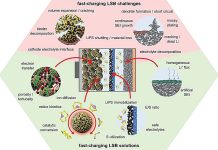
In a new study, researchers have found a new way to control light (photoluminescence) emitted by exotic crystal semiconductors.
This can help develop more efficient solar cells.
The research was led by researchers from Rutgers University.
Semiconductors like perovskites have properties that lie between materials conducting electricity and non-conducting insulators.
This means that their conductivity can be changed in a very wide range and used in many modern electronics.
Because of the existence of semiconductors, people can use a smartphone, the internet, high-resolution cameras, and supercomputers.
Previous studies showed that to change the intensity of photoluminescence, people had to change the temperature or apply enormous pressure to a crystal.
It can be quite cumbersome and costly.
In the current study, the team found a better way to control light emitted when perovskites are excited by a laser.
It involves crystals called hybrid perovskites (a type of semiconductor). They consist of interlocking organic and inorganic materials.
When adjusting voltage applied to an electrode on the crystal surface, the researchers could increase the light by up to 100 times.
It can be done within a small electronic device at room temperature.
According to the researchers, these crystals can lead to the development of new electronic displays, sensors and other devices activated by light.
This includes devices that control, generate or detect light, including solar cells, LED lights and light sensors.
Because hybrid perovskites are more efficient and much cheaper to make than standard commercial silicon-based solar cells, the findings can also help reduce the cost of solar energy manufacture.
In the future, the team will examine different types of perovskite materials.
This is the first study showing a material has been reversibly controlled to such a wide degree with voltage.
The lead author of the study is Vitaly Podzorov, a professor in the Department of Physics and Astronomy at Rutgers University-New Brunswick.
The study is published in Materials Today.
Copyright © 2019 Knowridge Science Report. All rights reserved.



